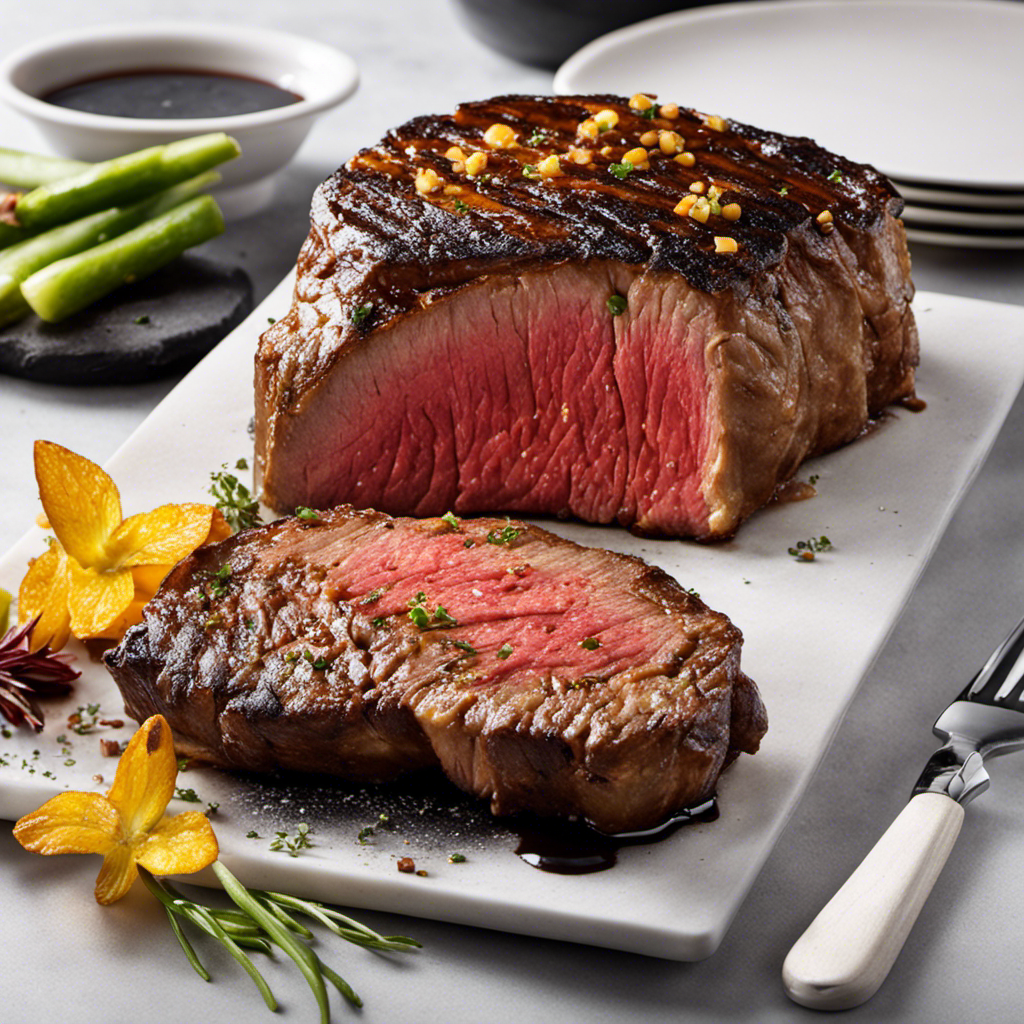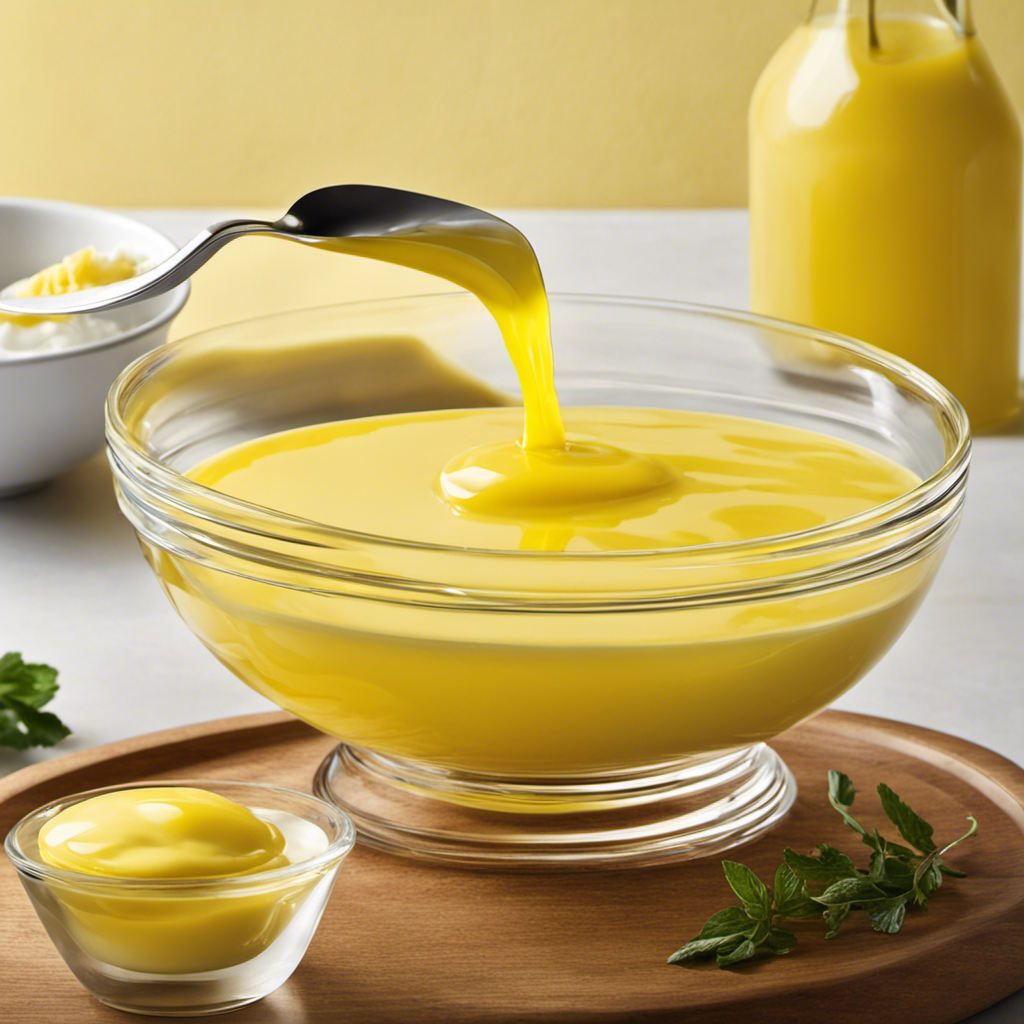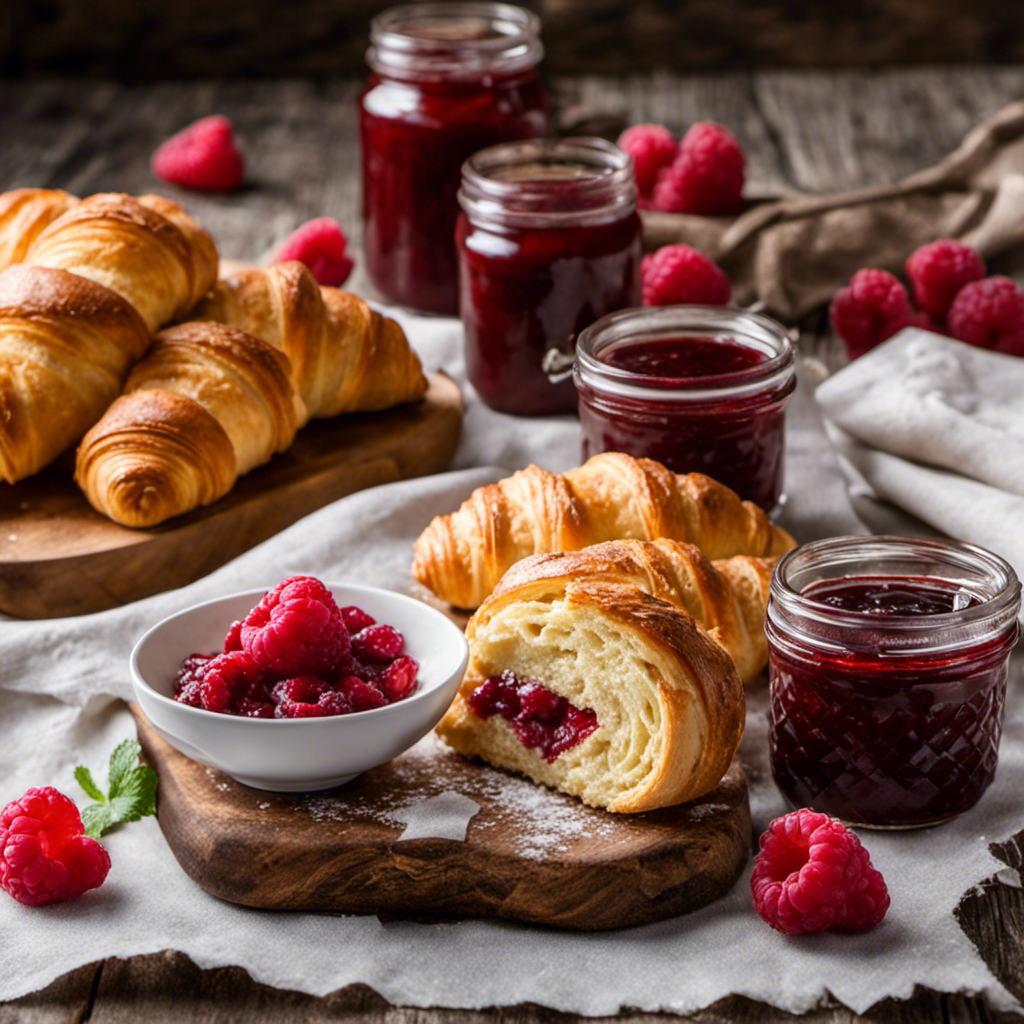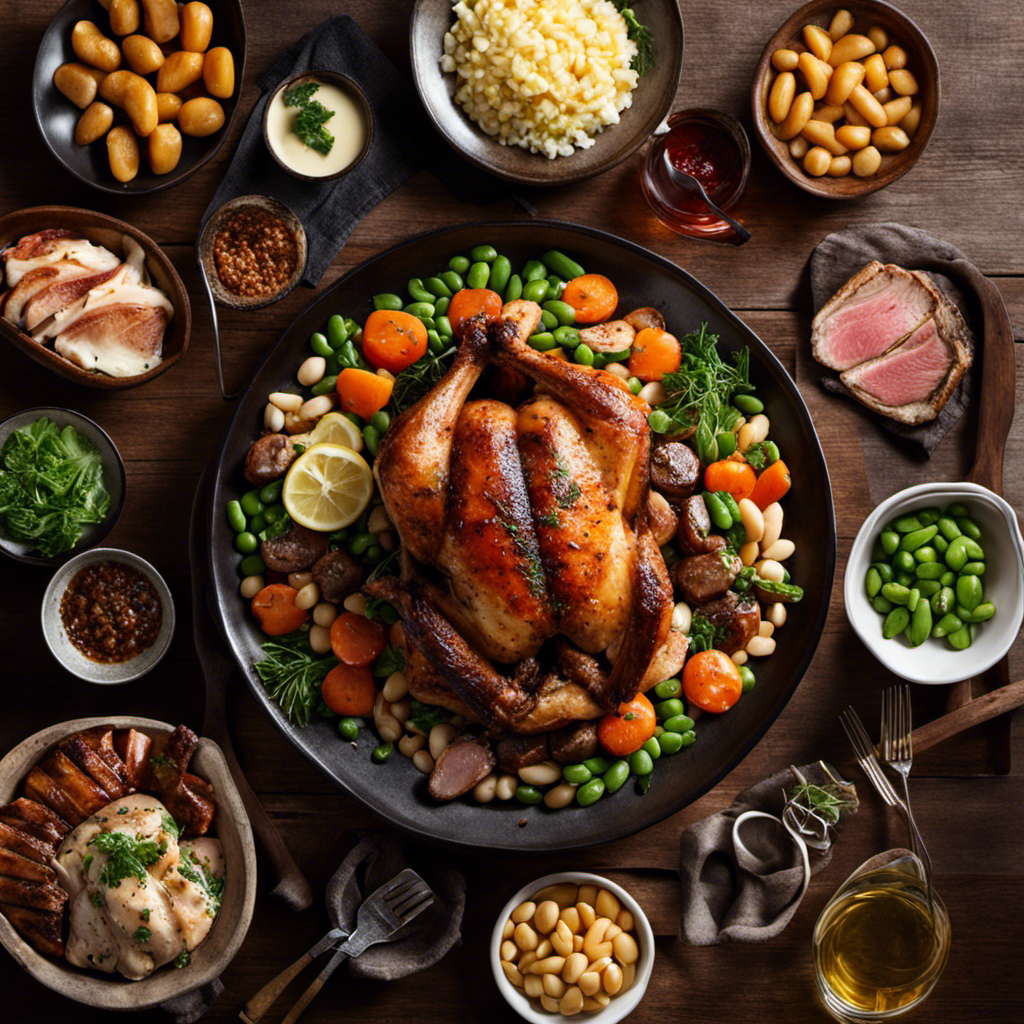I’m going to reveal a little secret that will take your steak skills to a whole new level.
Picture this: a sizzling hot pan, a juicy steak, and a pat of butter slowly melting over the top, infusing every bite with rich, savory flavor.
In this article, I’ll guide you through the art of basting a steak with butter, step by step. Get ready to elevate your cooking skills and impress your taste buds like never before.
Let’s dive in!
Key Takeaways
- Consider tenderness, marbling, and thickness when choosing a cut of steak.
- Soften the butter before mixing in other ingredients to prepare the butter basting mixture.
- Generously season the steak with herbs and spices before butter basting.
- Preheat the pan or grill before cooking to ensure even cooking and create a delicious crust.
Choosing the Right Cut of Steak
When choosing the right cut of steak, you’ll want to consider factors like tenderness, marbling, and thickness.
Tender cuts, such as filet mignon or ribeye, are more expensive but have a melt-in-your-mouth texture. Marbling refers to the fat distributed throughout the meat, which adds flavor and juiciness. Look for cuts with visible marbling for the best taste.
Thickness is important because it affects cooking time and temperature. Thicker cuts, like porterhouse or T-bone, are great for grilling, while thinner cuts, like flank or skirt steak, are better for quick cooking methods like pan-searing or stir-frying.
Once you’ve chosen the best cut, you can enhance its flavors by choosing the right marinade and cooking it to your desired level of doneness, whether it’s rare, medium-rare, medium, or well-done.
Preparing the Butter Basting Mixture
Before you start, make sure you’ve softened the butter. This step is crucial for achieving a smooth and creamy basting mixture. Once the butter is softened, it’s time to mix in the other ingredients to create a flavorful and decadent butter basting mixture. Here’s how to do it:
- In a small bowl, combine the softened butter with your desired seasonings. This could include minced garlic, chopped herbs like rosemary or thyme, salt, and pepper.
- Use a fork or a whisk to thoroughly mix the ingredients together. Make sure everything is well incorporated.
- If you want to add an extra kick of flavor, consider adding a splash of lemon juice or a dash of your favorite hot sauce.
- If you prefer a smoother texture, you can also melt the butter before mixing in the other ingredients. Simply microwave it for a few seconds until it’s melted but not hot.
Seasoning the Steak
To enhance the flavor of your meat, season it generously with your favorite herbs and spices. This is an essential step before butter basting your steak. The seasoning options are endless, allowing you to customize the taste to your preference.
Classic choices include salt, pepper, garlic powder, and paprika. However, you can also experiment with alternative seasonings like cumin, chili powder, or even a sprinkle of dried herbs like thyme or rosemary. The key is to coat the steak evenly on all sides, ensuring that the flavors penetrate the meat.
Once seasoned, the butter basting techniques will take your steak to another level of succulence and richness. Now that the steak is perfectly seasoned, it’s time to move on to the next step: preheating the pan or grill.
Preheating the Pan or Grill
Now that you’ve seasoned it, make sure the pan or grill is preheated to the right temperature. Preheating is essential for achieving a perfectly cooked steak.
Here are the benefits of preheating and some basting techniques to enhance the flavor:
-
Even Cooking: Preheating allows the pan or grill to reach the desired temperature evenly, ensuring that your steak cooks evenly as well.
-
Caramelization: Preheating creates a hot surface that helps to caramelize the natural sugars in the steak, resulting in a delicious crust.
-
Seal in Juices: By quickly searing the steak on a hot surface, you can lock in the juices and prevent them from escaping.
-
Enhanced Flavor: Preheating gives the steak a beautiful brown color and imparts a rich, smoky flavor.
With the pan or grill preheated, it’s time to move on to the next step: searing the steak to perfection.
Searing the Steak
Once the pan or grill is preheated, you’ll want to sear the steak to achieve a flavorful crust. Searing is a technique that involves cooking the steak at high heat for a short period of time. This process helps to lock in the juices and create a delicious caramelized exterior.
To achieve the perfect sear, make sure the pan or grill is hot before adding the steak. Place the steak on the hot surface and let it cook undisturbed for a few minutes, allowing the crust to form. Flip the steak and repeat on the other side. The searing process should only take a few minutes per side, depending on the thickness of the steak.
Once the steak is seared to your liking, it’s time to move on to the next step: adding butter to the pan or grill.
Adding Butter to the Pan or Grill
When it comes to cooking a steak, one important decision to make is whether to add butter to the pan or the grill.
Both methods have their own benefits and it ultimately depends on personal preference.
Adding butter to the pan can create a rich and flavorful crust on the steak, while adding butter to the grill can infuse the meat with a smoky and buttery taste.
Pan or Grill Method
To achieve a perfectly cooked steak, you can baste it with butter using either the pan or grill method. The butter basting technique adds richness and flavor to the steak, resulting in a juicy and tender meat. Here are alternative basting methods to consider:
-
Pan method: Start by heating a skillet over medium-high heat. Add a tablespoon of butter and let it melt. Once the butter is melted, carefully tilt the pan to collect the melted butter and use a spoon to continuously pour it over the steak. This helps to evenly distribute the butter and enhance the flavor.
-
Grill method: Preheat the grill to medium-high heat. Place the steak on the grill and cook for a few minutes on each side. As the steak cooks, melt some butter in a small saucepan or microwave. Once melted, use a brush to apply the butter onto the steak, turning it occasionally to ensure all sides are coated.
-
Herb-infused butter: Take your butter basting to the next level by infusing the butter with herbs. Simply melt the butter in a saucepan and add your favorite herbs, such as rosemary or thyme. Let the herbs infuse the butter for a few minutes before using it to baste the steak.
-
Garlic butter: For a flavorful twist, make garlic butter by melting the butter and adding minced garlic. Allow the garlic to cook in the butter for a minute or two to release its aroma and flavor. Use this garlic-infused butter to baste the steak, adding a delicious hint of garlic to every bite.
Benefits of Basting?
Using different basting methods enhances the flavor and tenderness of the cooked meat. Not only does basting add moisture to the steak, but it also imparts rich flavors that elevate the overall taste.
When basting with butter, the benefits are twofold. Firstly, butter adds a luxurious richness to the meat, creating a melt-in-your-mouth experience. Secondly, it helps to lock in the juices, preventing the steak from drying out during the cooking process.
Additionally, butter contains essential nutrients like vitamins A, D, E, and K, which contribute to overall health. These vitamins support various bodily functions, including eye health, bone strength, and immune system function.
Basting the Steak With Butter
Start by melting the butter in a pan and then spooning it over the steak to baste it. Butter basting techniques can enhance the flavor and juiciness of a steak, creating a delicious and succulent final result.
Here are some alternative basting methods you can try:
-
Herb-infused butter: Mix softened butter with your favorite herbs, such as thyme or rosemary, and baste the steak with this flavorful mixture.
-
Garlic butter: Melt butter and add minced garlic, then baste the steak for a rich and aromatic taste.
-
Citrus butter: Combine melted butter with freshly squeezed lemon or orange juice, providing a tangy and bright flavor to the steak.
-
Spiced butter: Mix melted butter with spices like paprika, cayenne, or cumin, and brush it over the steak for a bold and savory kick.
By using these different basting methods, you can customize the taste of your steak to suit your preferences.
Now, let’s move on to the next step of resting and serving the steak.
Resting and Serving the Steak
After removing the steak from the heat, let it rest for a few minutes before slicing it and serving. Resting time is crucial as it allows the juices to redistribute within the meat, resulting in a more tender and flavorful steak.
During this time, cover the steak loosely with aluminum foil to retain the heat. The recommended resting time varies depending on the thickness of the steak, but generally, 5 to 10 minutes is sufficient. This allows the steak to reach its desired internal temperature and ensures that it stays juicy when sliced.
Once the resting time is over, it’s time to plate the steak. Consider serving it with a side of roasted vegetables, a fresh salad, or a creamy mashed potato for a well-balanced and satisfying meal. Don’t forget to garnish the plate with some fresh herbs or a drizzle of sauce for an added touch of elegance.
Frequently Asked Questions
Can I Use Any Type of Steak for Butter Basting, or Are Certain Cuts Better Suited for This Technique?
Certain cuts of steak are better suited for butter basting. The marbling and thickness of cuts like ribeye or strip steak make them ideal for this technique. Butter basting enhances their flavor and creates a rich and juicy result.
How Long Should I Let the Butter Basting Mixture Sit Before Using It on the Steak?
I typically let the butter basting mixture sit for about 5 minutes before using it on the steak. This allows the flavors to meld together and ensures that the butter is at the right consistency. Resting the steak before serving is important to let the juices redistribute and keep it tender.
Is There a Specific Type of Butter That Works Best for Basting a Steak?
Well, when it comes to basting a steak with butter, there isn’t a specific type that works best. Personally, I like to use unsalted butter because it allows me to control the seasoning. However, there are also alternatives to butter, like olive oil or ghee, that can give your steak a delicious flavor. So, feel free to experiment and find what works best for you!
Can I Use Any Other Seasonings Besides Salt and Pepper to Season the Steak Before Basting?
Yes, you can definitely use other seasonings besides salt and pepper to season the steak before basting. Some popular options include garlic powder, paprika, and rosemary. Experiment and find what flavors you enjoy!
How Long Should I Let the Steak Rest Before Serving It?
I usually let the steak rest for about 5-10 minutes before serving. This allows the juices to redistribute and the meat to become more tender. It’s important to properly rest a steak before serving to ensure the best flavor and texture.
Conclusion
In conclusion, basting your steak with butter is a game-changer when it comes to flavor and tenderness. The process of basting allows the butter to infuse into the meat, resulting in a mouthwatering and succulent bite.
By following the steps outlined in this article, you’ll be able to create a restaurant-quality steak right in your own kitchen. So, why settle for a plain steak when you can elevate it to a whole new level of deliciousness?
Give butter basting a try and indulge in a truly extraordinary culinary experience.









